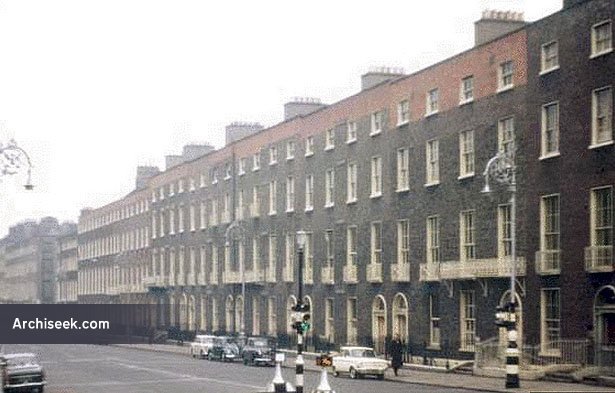Random Building
Interview with Sir John Summerson on Lower Fitzwilliam Street

An interview by John Mason, from Trinity News, later republished by the Irish Georgian Society in a bulletin early 1962. Sir John Summerson (25 November 1904 – 10 November 1992) was considered one of the leading British architectural historians of the 20th century.
What is your reply to the charge that you were called in to pronounce the last rites over the buildings in Lower Fitzwilliam Street?
“I was simply called in to give an opinion and was given every opportunity to study the problem. Until I had done so I did not expect that I should advise against preservation.”
Why did you not think that for the sake of the rest of the facades the buildings should be saved?
“It has no special architectural coherence; it is not a planned façade nor an architectural entity. It is simply one damned house after another; this does not constitute architectural unity. It does not even constitute uniformity; for the houses are a sloppy, uneven series. I do see that for the sake of uniformity of character over a wide are there was some real point on considering preservation, but on balance it seemed to me wrong. It is nearly always wrong to preserve rubbish, and by Georgian standards these houses are rubbish.”
Do you then think that the merit of Dublin architecture of this sort has been over-estimated, and that preservation must center rather on the large public buildings or country houses of the Georgian period?
“I think that the quality of these houses has been grossly over estimated, but I would not confine preservation to major buildings. Planned group of buildings even when perfectly plain can be very valuable. I would not, for instance, wish to see Merrion Square or Upper Mount Street disturbed. The problem is that many people who want to preserve Georgian things lose all sense of Georgian values. I have seen the Place Vendome and the Regents Park terraces mentioned an analogous to Fitzwilliam Street. If we come to think as loosely as that, preservation becomes sheer lunacy!”
Did you form any opinion at all, whilst your were in Dublin, of what should be preserved in the Merrion Square and Fitzwilliam Square area?
“No, I did not. That would require a very detailed study. I must emphasise, though, that such a study (of the whole Georgian area with a view to selecting the most significant portions) seems urgently required. It would not, I think, be reasonable to sterilise the whole area but control is essential. I am sure that many people for like to see a Government commission set up for this purpose. I would foresee the absolute preservation Of Merrion Square and Fitzwilliam Square, and of parts of the adjacent streets. There are long stretches of negligible importance where opportunities for development might be allowed, but I would emphasise that it must be controlled development in order to preserve skyline, continuity of rhythm and general character. We do not wish Georgian Dublin to explode into a variety of personal ”interpretations of the modern idiom.” Discipline is the main virtue of the old, let us have discipline in the new.”
Did you meet any of those bodies interested in the preservation of Lower Fitzwilliam Street, whilst you were in Dublin?
“No. I made a point of meeting as few people as possible”
How do you go about your examination of the buildings? Did you have expert advice on their conditions at hand?
I was conducted round all the houses and given full information about their conditions. But the condition of the houses, although pretty bad, did not worry me. You can preserve anything if it is worth preserving. There are much more important things in Dublin than the preservation of Lower Fitzwilliam Street. What is the future of Henrietta Street? Herre are houses of exceptional quality and rare historic interest. The same principles apply on the North side of the city as on the south, though I appreciate that this is a more difficult problem owing to the type of occupancy, re-housing needs and so on.”
Do you think the decision to demolish Lower Fitzwilliam Street minus two houses an extremely dangerous precedent?”
It poses a problem which has got to be faced sooner or later, as it has been faced (or sometimes, alas, not faced) in every historic capital. Dublin is a living city, and you cannot stop a living city from growing. Planning, rebuilding, and preservation have got to be considered together as aspects of the same problem, the problem of intelligent and civilised growth.
Published May 16, 2024
